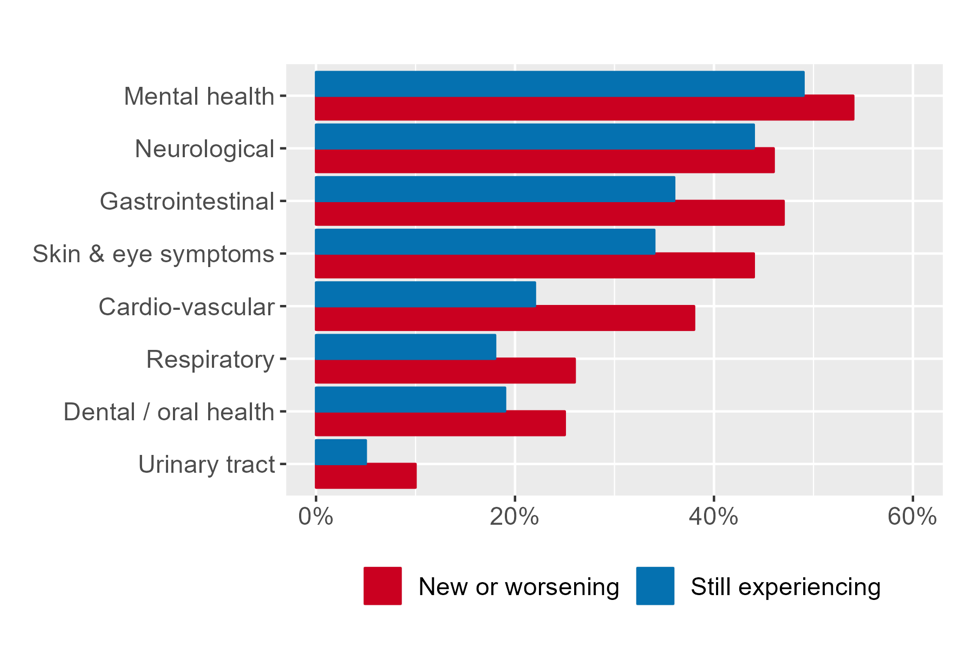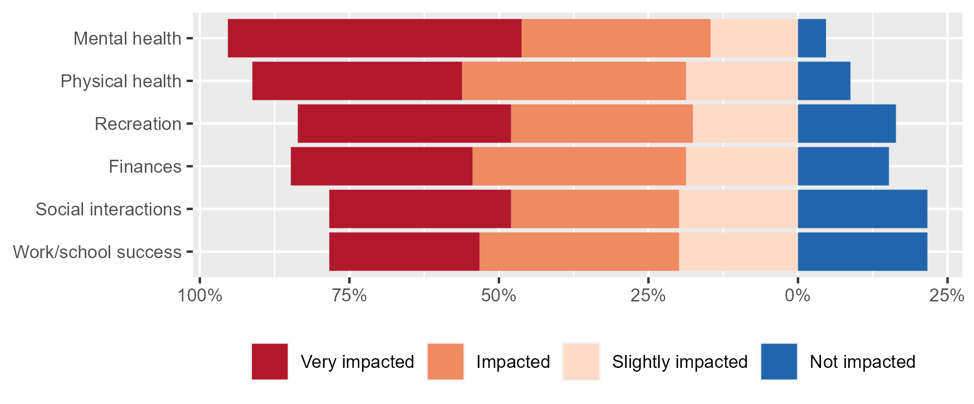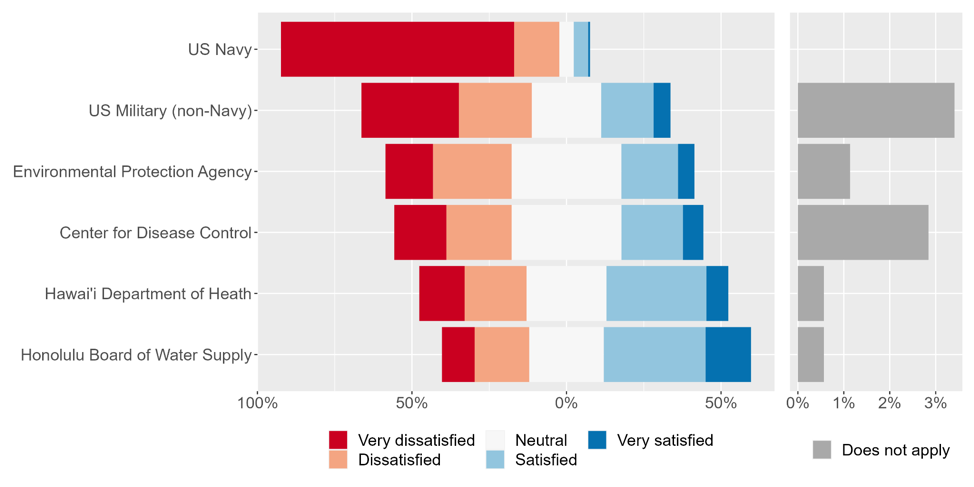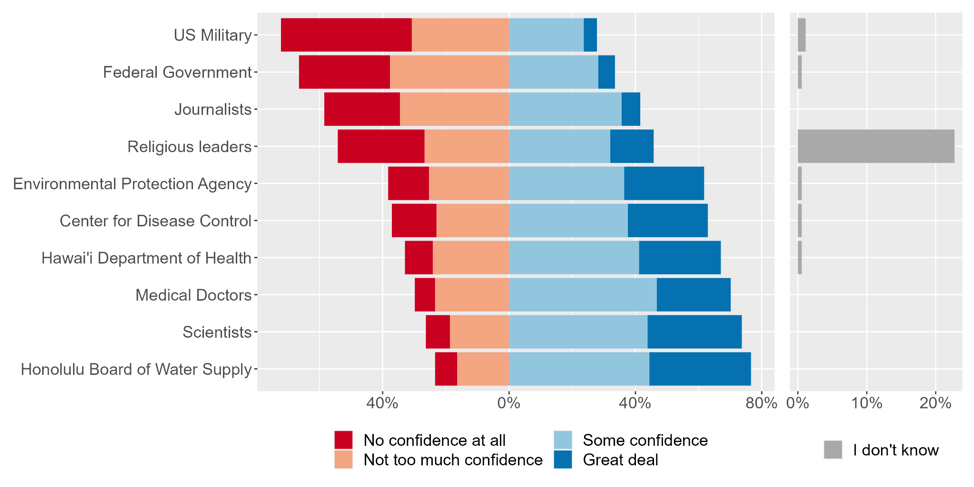BLOG POSTS ARE PRELIMINARY MATERIALS CIRCULATED TO STIMULATE DISCUSSION AND CRITICAL COMMENT. THE VIEWS EXPRESSED ARE THOSE OF THE INDIVIDUAL AUTHORS. WHILE BLOG POSTS BENEFIT FROM ACTIVE UHERO DISCUSSION, THEY HAVE NOT UNDERGONE FORMAL ACADEMIC PEER REVIEW.
By Leah Bremer, Tara Sutton, Ruben Juarez, Nicole Siegal, Nathan DeMaagd
*University of Hawaiʻi Economic Research Organization (UHERO), Water Resources Research Center (WRRC), Department of Geography and Environment, University of Hawaiʻi at Mānoa.
Background
On November 20, 2021 the Red Hill Bulk Fuel Storage Facility leaked approximately 19,000 gallons of jet fuel into the Pearl Harbor aquifer, the primary source of Oʻahu’s drinking water. The event directly contaminated the Red Hill well, impacting the Navy Water System, which provides water to about 93,000 people. The State of Hawaiʻi Department of Health (HDOH) urged Navy Water System users to stop using tap water on November 30th, 2021. Consequently, approximately 93,000 people were potentially exposed to jet fuel for at least ten days before switching to an alternative source.
In the months following the contamination, the HDOH and Centers for Disease Control Agency for Toxic Substances and Disease Registry (CDC/ATSDR) conducted a convenience sample of 2,289 water users to assess immediate physical and mental health impacts. Eighty-six percent of respondents reported at least one new or worsening physical or mental health symptom since November 20, 2021. [1] A follow-up survey in September 2022 of 986 respondents found that 80% continued to report symptoms. [2] These findings raise concerns as to the ongoing physical and mental health impacts as well as various social and economic repercussions from economic challenges to trust in institutions.
In response, UHERO, the Water Resources Research Center (WRRC), and the Department of Geography and Environment conducted a survey in July 2023 with Navy water users who had participated in the 2021 and 2022 surveys. This latest survey is part of the UHERO rapid health survey, allowing for a comparison of health impacts between those affected by the spill and those who were not. The CDC/ATSDR supported recruitment by sending an email to previous survey participants who had provided contact information (n= 1,900). Of these, 174 people completed the survey, representing a nine percent response rate. Respondents included active duty service members primarily from the Army, Navy, and Air Force (21%), reservists (2%), Department of Defense employees (17%), dependent family members (54%), retirees (7%), and those not affiliated with the military (9%). A longer and more intensive recruitment strategy may allow for a larger survey respondent group in the future, but this survey provides a glimpse into the experiences of water users about 2 years after the event. In this blog post, we provide high-level preliminary results focused on self-reported ongoing physical and mental health symptoms, overall household impacts, and levels of trust in institutions. Detailed results will be shared in a UHERO report in the spring/summer of 2024.
Self-reported on-going physical and mental health symptoms

Overall, 79% of survey respondents said they experienced a new or worsening physical or mental health symptom after the November 2021 spill. The majority (87%) of those reporting new or worsening conditions since the fuel spill in November 2021 said their symptoms are ongoing, meaning that respondents continue to experience health impacts from the event two years later. Mental health (e.g., anxiety, sleep disturbance, agitation, depression) and neurological symptoms (e.g, brain fog, memory issues, migraines/headaches) were the most widely reported, with nearly half of the respondents reporting ongoing symptoms, followed by gastrointestinal (e.g., diarrhea, nausea, cramps) and skin and eye symptoms (e.g., dry/itchy skin, rashes, burning eyes, redness). Notably, about 92% of respondents reported shifting to an alternative water source after hearing the incident, and over 84% of water users who still live in the area continue to use an alternative source or filtered water. We will share specific symptoms in 2024 in our final report.
Self-reported household level well-being impacts


When asked about the perceived effects of the fuel spill on their household, mental health issues were perceived as having the greatest impact with 81% of respondents saying their household’s mental health was impacted or very impacted. This was followed by physical health (73% reporting their household was impacted or very impacted), recreation and leisure and finances (66% reporting their household was impacted or very impacted for both categories), social interactions and educational work successes (58% reporting their household was impacted or very impacted for both categories). Of those reporting financial impacts from slightly impacted to very impacted (85%), over 40% report that they continue to experience financial setbacks related to the event and aftermath.
Satisfaction with response to the crisis and trust in institutions


Satisfaction with institutional response to the crisis varied substantially. By far, the highest satisfaction was with the Honolulu Board of Water Supply, which had significantly higher levels of satisfaction than all other institutions except for the Hawaiʻi Department of Health. Satisfaction rates were significantly lower for the Navy and the US Military (non-Navy). The Centers for Disease Control and the Environmental Protection Agency ranked in the middle.


These results mirror reported levels of trust or confidence in various groups, with the highest levels of confidence expressed in the Board of Water Supply. Respondents reported similar levels of confidence in scientists, medical doctors, and the Hawaiʻi Department of Health. The US Military and Federal Government received the lowest rankings.
Additional results will be provided in spring/summer of 2024 as analyses of surveys and interviews are completed. With additional resources, we hope to expand this survey to include a wider number of impacted water users. For more information please contact Leah Bremer (lbremer@hawaii.edu), Tara Sutton (thsutton@hawaii.edu), and Ruben Juarez (rubenj@hawaii.edu).
Acknowledgements: This work was funded by the Hawaiʻi Department of Health. We thank the Center for Disease Control/ATSDR and the Hawaiʻi Department of Health for their support in helping to recruit participants. We also thank Mia Comeros Raynal and Aurora Kagawa-Viviani for their support as part of the University of Hawaiʻi Red Hill Task Force. We also thank Colin Moore for helpful feedback. Above all, we are grateful to the survey respondents who shared their stories and experiences with this crisis.
[1] Miko S, Poniatowski AR, Troeschel AN, Felton DJ, Banerji S, Bolduc MLF, Bronstein AC, Cavanaugh AM, Edge C, Gates AL, Jarvis M, Mintz NA, Parasram V, Rayman J, Smith AR, Wagner JC, Gerhardstein BG, Orr MF. Community health impacts after a jet fuel leak contaminated a drinking water system: Oʻahu, Hawaiʻi, November 2021. J Water Health. 2023 Jul;21(7):956-971. doi: 10.2166/wh.2023.109. PMID: 37515565.
[2] https://health.hawaii.gov/about/files/2022/11/ATSDR-Follow-Up-Survey-One-Pager.pdf



